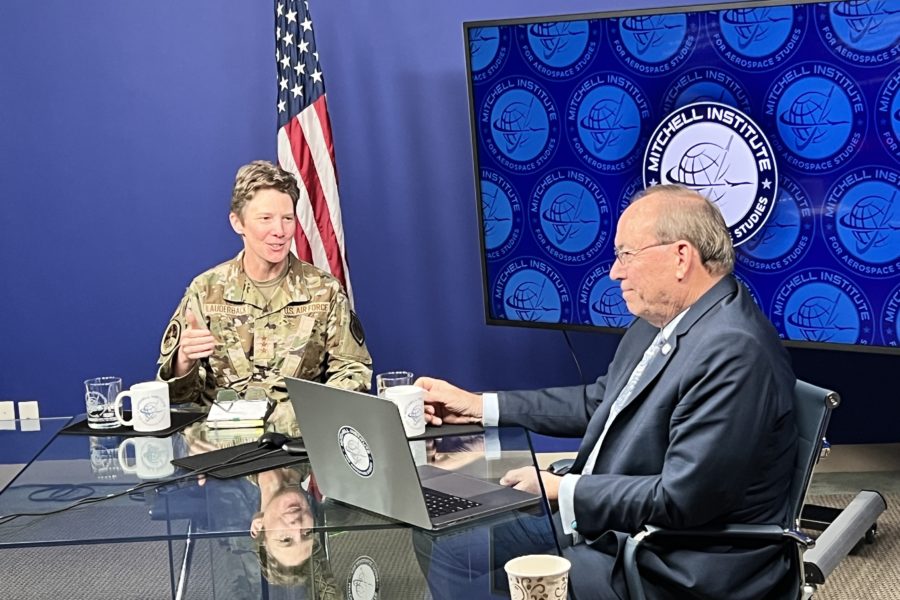As the Air Force plans to retire many of its aging intelligence, surveillance, and reconnaissance aircraft in the next few years, its looking to the Space Force and Intelligence Community to fill potential gaps and gain persistent coverage around the globe, the service’s top intelligence officer said May 17.
USAF budget documents show plans to divest the entire fleet of E-8s, U-2s, and RQ-4s by fiscal 2027, with the E-3 AWACS fleet also slated to be cut significantly. Deputy chief of staff for ISR and cyber effects operations Lt. Gen. Leah G. Lauderback said the changes are necessary and unavoidable.
“I think that the Air Force has had a difficulty messaging this,” Lauderback said during one of AFA’s Mitchell Institute for Aerospace Studies Aerospace Nation events. “The truth is, [the divestitures] were backed up by a number of studies over the last number of years, that this is the right thing to do in order to get ready for a peer competitor.”
Lauderback said the current ISR aircraft cannot survive in a conflict with China or Russia. But the fact that the divestments are happening without immediate replacements—at least publicly acknowledged ones—means there may be “small gaps” in ISR during the transition, officials have previously said and Lauderback confirmed.
“It’s not something that the Air Force is going to do by ourselves,” Lauderback said. “This is a team sport, and that team includes the intelligence community. We continue to have conversations with the intelligence community, primarily with the [National Reconnaissance Office], but also the combat support agencies, who are the functional managers for those capabilities.”
The Air Force faces a short-term gap in capability at a crucial time when experts see China building capability with an eye toward a potential future invasion of Taiwan.
“We all understand that we’re working in competition right now and then we’ve got to be prepared for conflict,” Lauderback said. “And none of us wants to have a gap. And so we’re going to address that as best as we can, … through Space Force as well as the intelligence community.”
Space-based ISR will be pivotal in the years ahead, as new satellite technologies mature. “We’re going to have incredible amounts of sensors that are coming that are space-based and thus have a certain amount of resiliency, more resiliency or more survivability, certainly, than some of the airborne capabilities that [the Air Force is retiring],” said Lauderback.
Satellites are also more persistent, able to stay on constant watch, something airborne platforms cannot do. When Lauderback was director of intelligence for Operation Inherent Resolve in the Middle East, the command lacked the ability to keep constant watch. “We didn’t have persistence to be able to chase ISIS around” with Joint STARS aircraft, she said. “The things that we had persistence with were [uncrewed] MQ-9s, Global Hawks would help us for sure. But in a permissive environment like that you can have that persistence. That persistence is very, very satisfying as a targeteer—somebody that wants to be able to track, in this case, ISIS maneuvering from one place to the next. We need to do that for peer competitors as well, for when or if we go into conflict, … before conflict even.”
Of course, making all those connections and ensuring the Air Force and other branches have access to all the intelligence they need presents other challenges. Lauderback called for more table-top exercises for the Pentagon to help determine and inform what space-based ISR will look like in the coming years.
But at the moment, she said she is encouraged by the Air Force’s conversations with the Space Force and Intelligence Community.
“I would actually tell you that any space-based ISR—whether it’s owned by an intelligence agency today or if it is a DOD entity—you can use those things in tactical environments,” Lauderback said. “It’s just a matter of the scale that you can do, how long it is that you can use those in a tactical sense. So we certainly have experience using those in a tactical sense today and nothing that stops us from doing that in the future.”
Lauderback’ has unique insight into how the Air Force and space-based ISR can work together, given her stints ‘s tour as the Space Force’s first deputy chief of space operations for intelligence and as U.S. Space Command’s director of intelligence give her particular insight into what space can do for the Air Force. And she’s hard at work trying to access whatever the IC can offer the military branches.
“The space-based layer … does not necessarily [belong] to the Intelligence Community,” she said. “We’re in these conversations right now, the departments, both DNI and the DO. So we’ll see what comes out of that.”
